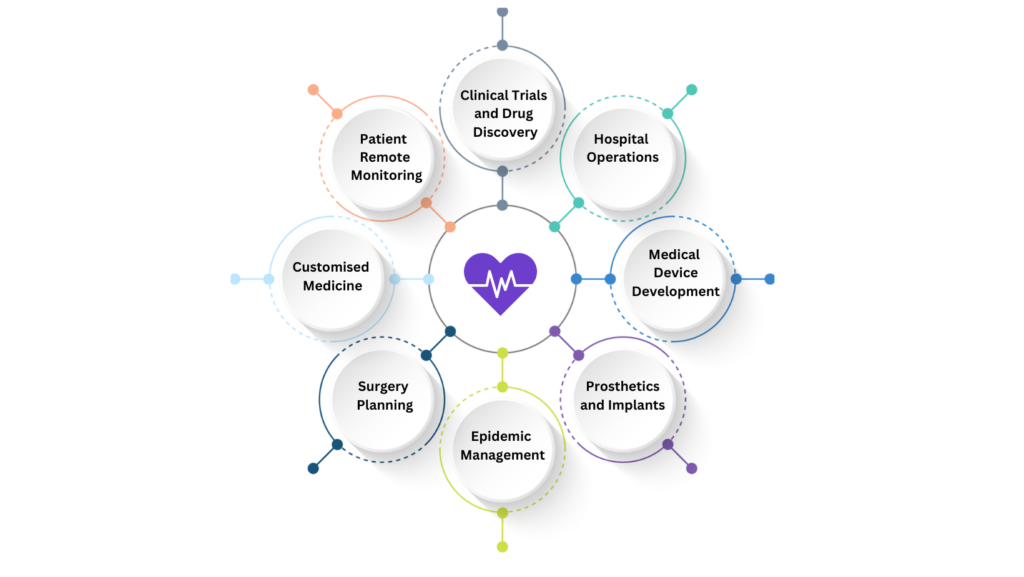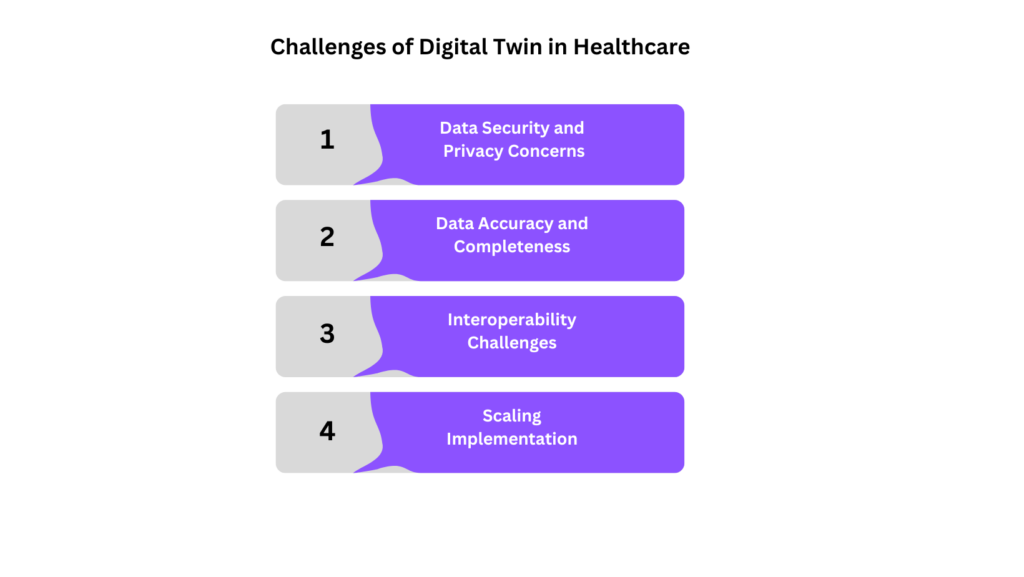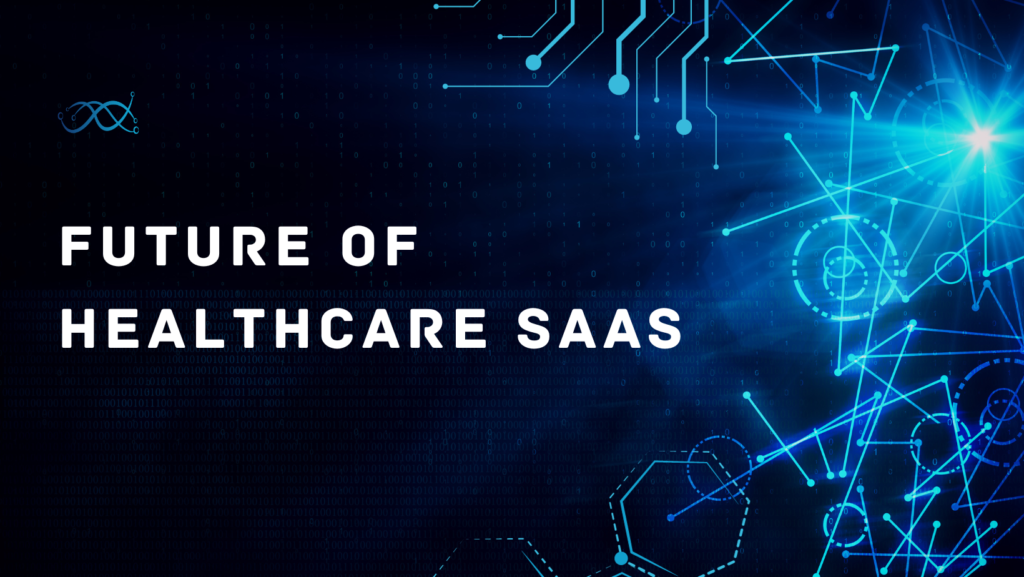Digital twins are just some of the new technologies that are quickly transforming the healthcare sector. These virtual copies are essential aspects of ensuring better practices in the healthcare industry, benefiting medical organizations and patient care. In particular, digital twins in healthcare were estimated to be worth about $1.6 billion in 2024. Experts in this industry expect significant growth in 2028 when the market will be worth over $21.1 billion. The phenomenal exponential growth year after year is truly an amazing feat.
Furthermore, it has been found that approximately 66% of healthcare executives plan to boost their investments in healthcare robots over the next three years. This strong confidence in the capabilities of digital twins serves as compelling evidence of the remarkable advantages these state-of-the-art technologies bring to both patient care and operational management.
It’s crucial to highlight that this trend is not merely a temporary phenomenon but rather a definitive shift in the technological landscape of health management. This article will investigate the significance of digital twins in healthcare, showcasing the advantages, potential, and challenges associated with this transformative technology.
Understanding Digital Twins in Healthcare
Digital Twins within the healthcare domain are computerized representations of a system, encompassing everything from patients to hospitals, including both physical entities and processes. These digital counterparts integrate electronic health records (EHRs), disease registries, and various omics data such as proteomic, genomic, metabolomic, and bionic data. Additionally, they encompass demographic and lifestyle information for each individual.
The integration of new technologies, driven by the IoT and AI, alongside the widespread accessibility of multidimensional data encompassing behavioral, biometric, cognitive, emotional, and psychological information, has played a pivotal role in fueling the increased exploration and practicality of digital twins.
Through optimal utilization, digital twins in healthcare have the potential to establish a groundbreaking paradigm for the future management of lifestyle, health, wellness, and chronic diseases. To illustrate, these virtual models can continually receive updates from wearable devices, mobile health apps, and various self-reported data sources. This influx of information provides healthcare providers with unprecedented insights, crucial for formulating precise treatment guidelines and personalized advice that were previously unavailable to them.
According to Liu., digital twins in healthcare involve the application of intricate modeling techniques and tools for constructing DT models. Real-time data connectivity and exchange between physical and virtual entities are facilitated by Health Internet of Things (IoT) and mobile internet technologies.
Advantages of Digital Twins Technology in Healthcare
The application of digital twins in healthcare is extensive, extending to the creation of a digital representation of the human body. In light of this, here are several significant advantages linked to incorporating digital twins in healthcare:

Enhanced Patient Care
Utilizing the digital twin of a patient, a physician can simulate treatments, aiding in crucial decision-making before proceeding with physical procedures on the individual. This method is intended to enhance procedural safety while elevating the quality of care provided.
Predictive Maintenance
In the healthcare context, digital twins can be employed to forecast potential failure scenarios and conduct predictive maintenance on essential medical devices. This capability allows healthcare providers to consistently monitor device performance, anticipating and preventing breakdowns that could otherwise occur during critical medical procedures.
Augmented Training and Education
Digital twins are poised to emerge as a crucial platform for enriching the training and educational experiences of medical and nursing students, along with other healthcare professionals. They provide learners with an interactive platform, aiding in the comprehension of intricate surgical procedures and conditions of the human body.
Research and Development
Digital twinning plays a pivotal role as a crucial tool in medical investigations. These virtual replicas serve as platforms for conducting various research experiments and delving into the complexities associated with genetic disorders. This has the potential to significantly reshape healthcare strategies and medical treatment protocols, particularly for rare and intricate cases.
Optimization of Healthcare Systems
Digital twins assist healthcare institutions in identifying operational inefficiencies and bottlenecks within their systems. This proactive analysis empowers managers to optimize resources, thereby improving patient flow and the delivery of services.
Additionally, explore the top healthcare trends set to redefine the industry in 2024.
Use Cases of Digital Twins in Healthcare
Digital twin applications in healthcare span various areas encompassing patient care and hospital/medical services. The popularity of utilizing digital twins is on the rise, and this section outlines essential applications that contribute to the enhancement of medical services and patient care.

1. Clinical Trials and Drug Discovery
The utilisation of digital twins in healthcare showcases an innovative approach to addressing the ethical and logistical challenges associated with conducting clinical trials and drug development. These virtual models simulate intricate biological processes and responses within the human body.
2. Patient Remote Monitoring
Digital twins have evolved into a priceless tool for remotely monitoring the well-being of patients and delivering timely care or treatment. This capability is particularly beneficial for individuals residing in remote areas or facing mobility challenges. In essence, with these virtual counterparts, healthcare professionals can continually access real-time data to identify deviations from the norm, enabling prompt interventions and the implementation of a preventive approach in medicine.
3. Customised Medicine
In the realm of patient care, the utilisation of digital twins represents one of the most advanced approaches. By leveraging extensive patient-specific data, these digital counterparts play a pivotal role in determining a personalised treatment approach that considers an individual’s distinct health conditions, genetics, lifestyle, and specific medical needs.
4. Surgery Planning
The incorporation of digital twins in healthcare plays a vital role in transforming surgical planning and preparedness. By generating detailed 3D models of the specific anatomical structures of individual patients, healthcare professionals can accurately visualise and simulate virtual surgical procedures, anticipating and mitigating challenges while optimising surgical plans. This thorough pre-operative planning contributes to the reduction of complications, shorter operating times, enhanced surgical precision, and improved post-surgical recovery.
5. Epidemic Management
In the context of managing a pandemic such as Covid-19, digital twins can play a crucial role. With access to diverse data, including information about social gathering locations, population density, the availability of healthcare facilities, and more, these technologies empower medical professionals to make well-informed decisions.
6. Prosthetics and Implants
A novel approach in the development and customization of prosthetics and implants for individuals with unique anatomical requirements leverages digital twins to ensure an optimal fit and functionality.
For instance, by creating digital replicas of patients’ injured body parts, healthcare professionals can design prosthetics and implants with high precision, accounting for each patient’s specific anatomical structures to ensure comfort and mobility. These digital representations can also be utilized to simulate post-procedure movements and rehabilitation exercises. This aids physiotherapists in prescribing personalized rehabilitation programs, expediting recovery, and enhancing the quality of patients’ lives.
7. Medical Device Development
The incorporation of digital twinning in medical device development enables comprehensive virtual testing and research. Developers can assess the impacts of design variations, explore different operating conditions, and anticipate potential malfunctions by constructing virtual replicas of medical instruments before moving forward with the production of actual units.
This proactive approach proves cost-effective and diminishes the risk of product failures in healthcare. Additionally, it accelerates the time to market for these life-saving products. The implementation of digital twins in healthcare empowers developers to deliver devices that are both safe and high-performing, aligning with rigorous safety standards to enhance patient care and healthcare outcomes.
Explore more: A Comprehensive Guide to Healthcare Compliances.
8. Hospital Operations
The application of digital twinning in hospital operations involves creating virtual counterparts that enable the evaluation and optimization of various aspects of healthcare administration. Hospital managers can utilise digital twins to assess the effectiveness of their resources, enhancing bed management, staff scheduling, and operation room utilisation. This optimised utilisation of resources contributes to enhanced hospital performance and staff efficiency, ultimately reducing operational costs.
Real-World Examples of Digital Twins in Healthcare
Presented below are two tangible examples of digital twins in healthcare, exemplifying the innovative approaches through which this technology is revolutionising both patient care and healthcare administration.
1. Babylon Digital Twin for E-medical Records
The Babylon Digital Twin platform stands out as a forefront solution that empowers individuals to gain a comprehensive understanding of their medical records and other health-related information. Leveraging advanced AI sophisticated technology and deep learning techniques, the system furnishes crucial insights into organ status and factors predisposing to diseases.
2. Hospital Ward Management Digital Twin at Mater Hospital Dublin
The Mater Hospital Dublin illustrates how digital twinning transforms healthcare, optimizing hospital operations. Utilizing 3D digital replicas, Mater Hospital critically assessed daily ward functions, notably improving the radiology department and leading to a substantial decrease in patient wait times for critical CT and MRI scans, ultimately enhancing the overall patient experience through the digital twin initiative.
Implementing workflow-simulated digital twins at Mater Hospital resulted in a remarkable 240-minute reduction in wait times for CT or MRI scans. This optimization significantly shortened patient turnaround times, leading to a notable increase in MRI and CT scan capacities by 32% and 26%, respectively.
Challenges of Adopting DIgital Twin Technology in Healthcare
Embracing digital twin technology in healthcare comes with various challenges that necessitate careful consideration and mitigation at each stage of implementation. Here are some of the primary hurdles:

1. Data Security and Privacy Concerns
Utilising vast amounts of sensitive health information, digital twinning in healthcare requires robust measures to ensure data security and privacy. Safeguarding against breaches or unauthorized access is imperative, and data encryption becomes a necessity to uphold patient confidentiality, adhering to compliance standards such as HIPAA in the US and GDPR in Europe.
2. Data Accuracy and Completeness
Ensuring accuracy and completeness in data input is a primary concern for digital twins. Achieving a comprehensive and precise medical history, encompassing genetic information, lifestyle factors, and real-time health data, requires meticulous attention to detail and the implementation of a sophisticated data collection system.
3. Interoperability Challenges
Interoperability challenges emerge when attempting to link, compare, and integrate health data from various sources without standardised interoperability. Addressing this issue involves promoting data interoperability, necessitating the standardisation of data formats and harmonisation of different data systems to facilitate the accurate and timely exchange of information between diverse healthcare platforms.
4. Scaling Implementation
Scaling the implementation of digital twins for healthcare applications introduces distinct challenges during the transition from the pilot phase to widespread adoption across diverse health service environments. The deployment of healthcare digital twins raises fundamental queries about effectively handling data integration complexities, adhering to existing regulatory frameworks, and establishing standardised practices and approaches. To unlock the full potential benefits of digital twins in healthcare, it becomes imperative to foster collaborative partnerships and cultivate a culture that values innovation and flexibility.
Also Explore: How Digital Twin Technology Can Contribute to the Growth of Your Business.
The Future of Healthcare
The potential revolutionization of patient care, healthcare operations, and research lies in the adoption of digital twins in healthcare. This transformative step is expected to bring about significant changes in communities and alter the delivery of patient care.
As per the findings of the Twindex report, more than half of the participants expressed the belief that the acceptance of digital twins in healthcare facilities will increase in the next six years. Additionally, 52% of respondents anticipate widespread utilization of digital twinning technology in healthcare and the life sciences industry within the next three years.
Explore more: Will Blockchain Revolutionise Healthcare? Separating Fact from Hype.
Let Digiatto IT services Be Your Partner in Digital Twin Adoption
The evolution of digital twins in healthcare represents a revolutionary technology capable of reshaping patient care and optimising operational efficiency, among other processes.
An impactful illustration of this technological trend is YouCOMM, a versatile patient portal empowering in-hospital patients to promptly connect with nurses for their basic needs. This involves patient communication using either manually selected voice commands or head gestures. The application of digital twin technology in healthcare in such contexts has the potential to enhance patient care delivery and optimize healthcare services.
If the innovative model of YouCOMM sparks your interest and you aim to create similar solutions, our healthcare software development services are tailored for you. With a dedicated team, we craft and deliver bespoke healthcare products that align with evolving industry needs. Let us accompany you on the journey to harnessing the potential of digital twins in healthcare.
FAQs
Q. What is the digital twin concept in healthcare?
In healthcare, the digital twin concept involves generating digital representations of actual entities or procedures, including patients, organs, and entire hospital settings. This is achieved through the integration of modern technologies such as IoT and AI.
Q. What is an example of digital twinning in healthcare?
An example of digital twinning in healthcare is the creation of a digital replica of a patient’s body, incorporating health information, lifestyle data, and real-time monitoring data. This virtual counterpart aids in predicting and managing health issues, offering personalized treatment plans, and delivering preventive healthcare measures.
Q. What are the uses of digital twins in healthcare?
Digital twins in healthcare serve multiple purposes, including simulated patient treatment, training for doctors, optimization of the health system, maintenance of medical instruments, and research and development in medicine. They also contribute to improved surgery planning, disease modeling, and more effective epidemic administration.


